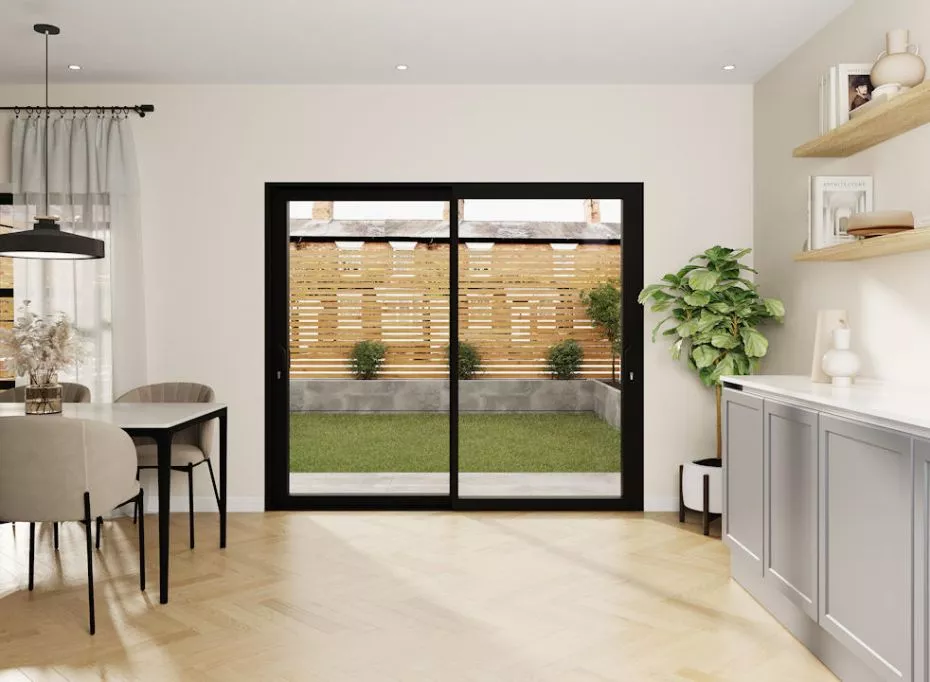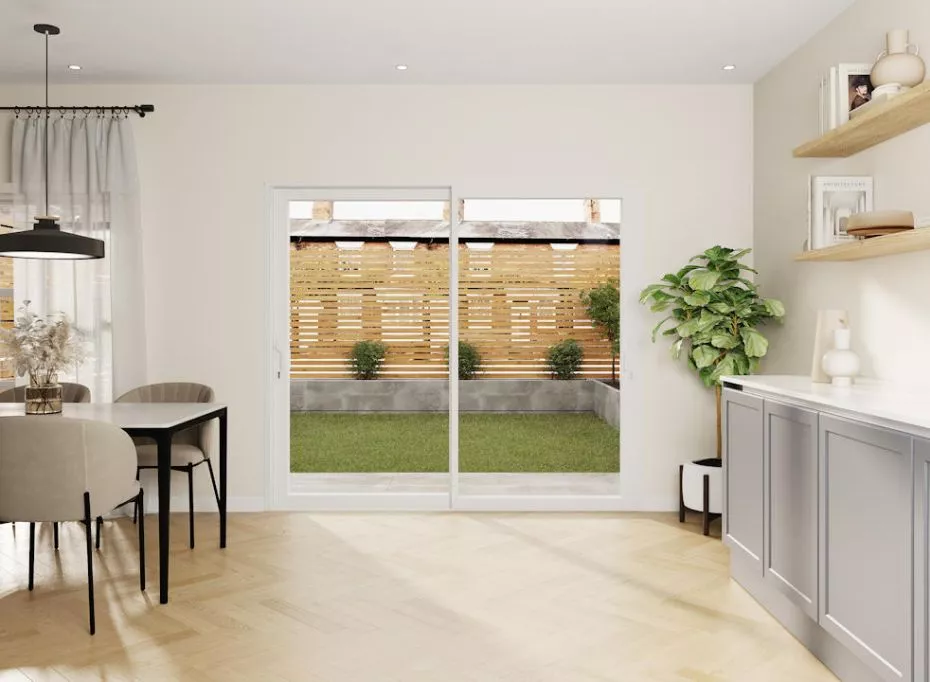Sliding door thermal efficiency | How to improve thermal efficiency with sliding doors
Sliding doors offer seamless access to outdoor spaces, expansive views, and an abundance of natural light. However, ensuring that a set of doors contributes to the energy efficiency of your home will play a huge part in maintaining a comfortable indoor environment and reducing energy bills.
Here, we explore the factors that influence the thermal efficiency of sliding doors, from materials and glazing to additional features. We also provide tips on choosing a thermally efficient sliding door.
In this guide:
Find out more about the different popular sliding door materials.
Read our guide to the different glazing options for sliding doors and their benefits.
Read the different thermal efficiency features of sliding doors.
Read our tips on maintaining your doors for long-term thermal efficiency.
We answer common queries on sliding door thermal efficiency.
What materials are available for sliding doors?
The choice of material for sliding doors has a significant impact on their thermal performance. Here are some of the most popular materials for sliding doors:
-
Aluminium: Aluminium is prized for its strength, durability, and sleek aesthetic. While it’s not a naturally thermally efficient material, modern aluminium and glass doors include thermal breaks. These are insulating barriers within the frame that significantly reduce heat transfer. Shop Vufold’s aluminium sliding doors here.
-
Timber: For a traditional and natural look, timber is an excellent insulator due to its low thermal conductivity. Engineered timber enhances durability while maintaining its insulating properties. Find out more about how timber compares to aluminium here.
-
uPVC: Unplasticised polyvinyl chloride (uPVC) is a popular option due to its affordability and inherent insulating properties. uPVC frames are lightweight, low-maintenance, and resistant to moisture, making them an energy-efficient choice for most climates. However, bear in mind that uPVC sliding doors tend to be less durable than other options.
-
Composite: Combining materials like timber and aluminium, composite frames offer the best of both worlds. They pair the thermal efficiency of timber with the durability of aluminium, ensuring high performance and a long lifespan.
When selecting a material, consider your home’s climate, design preferences, and maintenance requirements to strike the right balance between efficiency and practicality.
Are you choosing a new patio door? Read our complete guide to bifold doors vs sliding doors here.

What are the different glazing options for sliding doors?
The type of glazing in sliding doors significantly affects their thermal efficiency. Here’s what to look for:
-
Double or triple glazing: Double glazed units consist of two panes of glass with a sealed air gap between them. This gap acts as an insulating barrier, reducing heat transfer and improving energy efficiency. Double glazing is a standard choice for most homes. Triple-glazed units, on the other hand, offer an additional pane of glass and an extra insulating layer. However, triple glazed sliding doors are often slightly more expensive than double glazed sliding doors, so this is something to bear in mind when choosing the best option for you. Read our guide to double vs triple glazing here.
-
Low-emissivity (Low-E) coatings: Low-E coatings are a thin, transparent layer applied to glass that reflects heat back into the room while allowing natural light to pass through. This feature enhances thermal efficiency without compromising aesthetics.
-
Gas-filled panes: Filling the gap between glass panes with inert gases like argon or krypton further reduces heat transfer, enhancing the overall insulation of the sliding door.
When selecting glazing and features for your doors, consider your climate and energy-saving goals. Due to its nature, triple glazing can be heavy, which can put a strain on the hinges and frames of your folding doors so finding the right frame material is important. The highest quality double glazed sliding doors can achieve exceptional U-Values and provide excellent thermal efficiency. For example, Vufold Status Sliding Doors offer U-Values as low as 1.4 w/m2K, and the Supreme Sliding Doors offer U-Values as low as 1.6 w/m2K.
Bring in more natural light with the Supreme sliding door range
Our modern Supreme aluminium sliding doors are popular choice for many homeowners due to their sleek appearance, durability, and energy efficiency. They are made with high-quality, low maintenance aluminium frames.
These eye-catching modern external sliding door systems are supplied with low-emissivity (low-E) glass, and thermal breaks to further improve their impressive insulation and energy efficiency. Offering U-Values of only 1.6 W/m2K, you are guaranteed exceptional thermal efficiency for your home with our Supreme aluminium sliding door range.
From £2219

Seals, weatherstripping, and airtightness
Effective seals and weatherstripping are crucial for minimising heat loss and preventing drafts. Ensure that weatherstripping materials are durable and fit tightly around the edges of the door. Replace worn or damaged strips promptly to maintain efficiency. Properly installed seals and weatherstripping prevent air leaks ensure that your sliding doors operate efficiently year-round. You can shop our full range of aluminium sliding doors here.
Maintenance for long-term sliding door thermal efficiency
Regular maintenance is key to preserving the thermal efficiency of many types of doors. Maintenance tips include the following:
-
Clean tracks and frames: Dirt and debris can affect the door’s alignment and sealing. Clean the tracks and frames regularly to ensure smooth operation and airtightness.
-
Inspect seals and weatherstripping: Check for wear and tear on seals and weatherstripping. Replace damaged components promptly to maintain insulation.
-
Lubricate moving parts: Ensure that rollers and tracks are well-lubricated to prevent wear and maintain proper alignment.
-
Check glazing and frames: Inspect the glass and frames for cracks or damage that could compromise thermal performance. Address issues immediately to prevent further energy loss.
Consistent maintenance extends the life of your sliding doors and keeps them performing efficiently.
What U-Values do Vufold sliding doors offer?
One factor that makes Vufold sliding doors thermally efficient are the aluminium frames which feature a polyamide thermal break. This thermal break insulates the usual cold aluminium profile, thus creating a thermal bridge. Our sliding patio doors are double glazed and all come with an incredibly low U-Value of just 1.6 W/m2K. These eye-catching modern external sliding doors are supplied with low-emissivity (low-E) glass to further improve their energy efficiency.

Shop our aluminium sliding doors here.
How else can you improve thermal efficiency in the home?
Here are some additional ways in which you can improve your home's energy efficiency on a budget:
-
A great way to increasing thermal efficiency in the home is through adding loft insulation.
-
Consider improving the glazing of your windows.
-
Check for draughts. If you feel your home has cold draughts, you can cut these out by filling gaps around doors and windows.
-
Reduce loss of heat from your heating system by insulating pipes, tanks, and radiators.
Frequently asked questions
What materials are best for thermally efficient sliding doors?
Aluminium sliding doors with thermal breaks offer excellent thermal performance as well as exceptional durability. Timber is also a strong natural insulator, however, often requires more maintenance. Engineered timber can provide an extra level of durability and strength.
You can shop our range of aluminium sliding doors here.
How do I know if my sliding doors need new seals or weatherstripping?
Signs your doors need new seals or weatherstripping include drafts, visible gaps, or difficulty maintaining indoor temperatures.
Can sliding doors be retrofitted to improve energy efficiency?
Yes - options include upgrading seals, adding Low-E film, or replacing glazing units. Find out more about improving the thermal efficiency of patio doors here.
Are thermally efficient sliding doors worth the investment?
Thermally efficient sliding doors can reduce energy bills, enhance comfort, and even add long-term value to your home.
Do thermally efficient sliding doors work well in extreme climates?
Yes, provided they are equipped with appropriate glazing, materials, and seals. Choosing a reputable supplier also ensures your doors will be of the highest quality and provide excellent thermal efficiency.
What role does proper installation play in thermal performance?
Proper installation ensures airtightness and alignment, maximising thermal efficiency.
RELATED CONTENT

About John Collins
John has built Vufold into a unique online door and window company and has spent 20 years bringing innovative products and designs to fruition, recognising niches in the market and placing them in the likes of Wickes and Travis Perkins, he started Vufold in order to sell them directly. John founded Vufold and has amassed a wealth of experience in product design and development, and in particular timber-based products
Read more about John Collins

